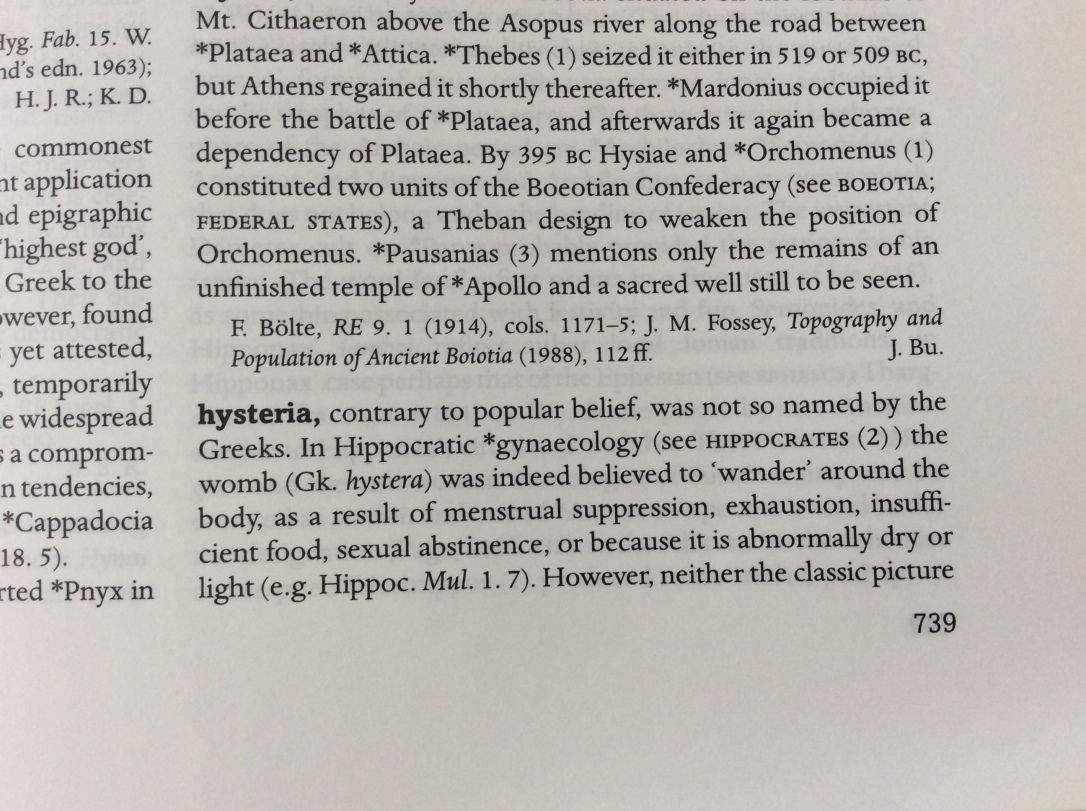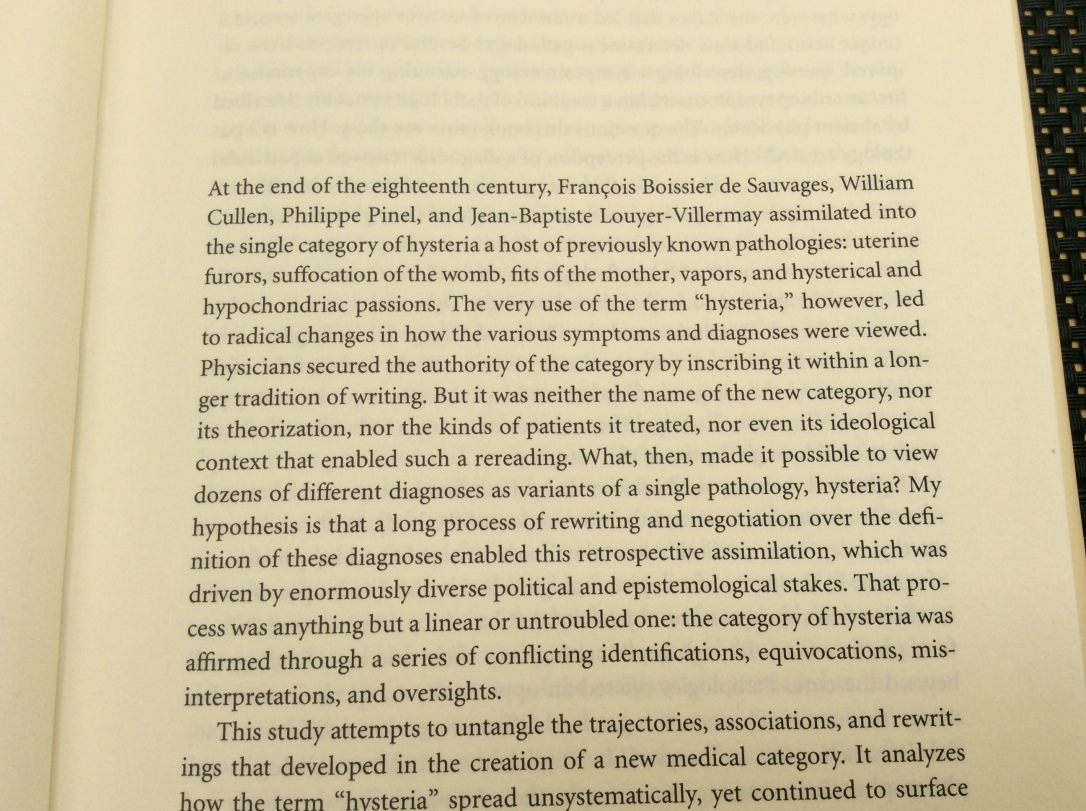(updated 20 September 2019 – and, thanks to Minji Lee of Rice University, a previous edit is available in Korean here)
Please can we just get something out of the way once and for all? The disease of ‘hysteria’ was neither described nor named by Hippocrates. I know The Sun says it was, but it’s wrong. And it’s by no means the first to be wrong. The myth is all over the place, trotted out at the beginning of many medical pieces trying to find continuity in views of the female body over two millennia or more, such as this 2012 article, one of many on open access which depend on outdated secondary sources for their ‘ancient world’ sections. The way in which medical writers today just accept something written about the ancient world 50 or more years ago is a problem which Professor Monica Green and I addressed in a recent letter to The Lancet. This is despite developments such as Paul Potter’s 2018 English translation of the ‘Hippocratic’ gynaecological texts for the Loeb Classical Library, where – quite rightly – the word ‘hysteria’ isn’t in the index.
In The Sun’s story, published on 17 July 2018, about a papyrus fragment now in Basel being identified as a medical text concerning ‘hysterical suffocation’, an information box states: ‘Galen’s belief was very similar to that of Hippocrates, “The Father of Medicine”, who was the first to coin the term “hysteria”.’ No, no, a thousand times no. Hippocrates didn’t ‘coin the term hysteria’. The word does not exist in ancient Greek. Sure, one of the words for ‘womb’ – just one of them – was hystera and clearly when the word ‘hysteria’ was invented it was a reference to the womb as the supposed origin of the condition. But that word wasn’t invented by Hippocrates, or any other ancient Greek. And while we’re at it, ‘Galen’s belief’ about – not ‘hysteria’, but something they called ‘hysterical suffocation’ in which the womb was exerting heat and pressure elsewhere in the body – was rather different from what the writers of the Hippocratic corpus had.
Short detour on the Hippocratic Corpus: it’s a group of medical texts spanning several hundred years and a range of beliefs about the body, which are almost entirely anonymous and none of them can be conclusively shown to be ‘by Hippocrates’ (not even the ‘Hippocratic Oath’). They got attached to his name at some point because he was mentioned by Plato and Aristotle as a great doctor so anonymous texts just stuck to him.
OK, back to the point. In the Hippocratic Corpus, hysterical suffocation is more likely if the womb isn’t irrigated by sex, because the womb was seen as mobile and needed to be ‘weighed down’. For Galen, though, the cause was retained seed, becoming poisonous and affecting other parts beyond the womb: no need for any womb movement, as the poison does the job. To give credit where it’s due, The Sun’s textbox does eventually mention the poison theory. And it doesn’t go so far as the 19 July Daily Mail (for which one source is clearly the Wikipedia ‘female hysteria’ article) which misses the point that this papyrus is from late antiquity while Galen was in the second century AD, and therefore assures us it was actually ‘penned’ by Galen…!
Making a news story
Where did The Sun get this all from? The basic news story was reported by the University of Basel on 12 July under the sober title Mystery of the Basel papyrus solved. Clever technology has revealed that ‘it is an unknown medical document from late antiquity. The text was likely written by the famous Roman physician Galen.’ It mentions ‘hysterical suffocation’, on which we have Galen’s thoughts already in his treatise On the Affected Places 6.5; I’ve discussed this in a paper on another misguided claim, this time about therapeutic masturbation. On 16 July LiveScience ran the story and did a rather better job than The Sun, even including some material from On the Affected Places. The Sun is rather late to the party, but has subsequently been followed by the Daily Mail and Metro.
When The Sun decided to run the story, of course, it needed to be pimped significantly. So the headline became ‘JULIUS PLEASE HER’ and the ‘Mystery of the Basel papyrus’ became ‘Mysterious 2,000-year-old scroll reveals crazy Roman medical theory that women became HYSTERICAL when they didn’t have sex’. From a papyrus fragment to a scroll… The scroll, according to the story, ‘had to be deciphered’; er, hello, it’s not in code, it’s in ancient Greek.
But where did The Sun find its additional information, all this stuff about Hippocrates naming ‘the’ condition? It could be that very same 2012 article I mentioned at the start of this blog post, which includes the line ‘Claudius Galen’s theories on hysteria (2nd century AD) are comparable to those of Hippocrates.’ Possibly, the journalist has used a very good source that’s online: the Women’s Lives in Greece and Rome (WLGR) collection of primary sources, which clearly lies behind this comment on Hippocrates: ‘He called this condition the “wandering womb”, which if unhappy as a result of this would float around the upper abdomen triggering “stiff breathing and sharp pains in the heart”, according to the text of his ‘Diseases of Women”.’ The Sun reporter could read this via a blog post which unfortunately also spreads the myth that ‘hysteria’ was an ancient diagnostic category. Metro, which ran the story on 19 July as a ‘bonkers Roman theory’, definitely went for WLGR and links to the passage of Diseases of Women 1.126, of course assuming that everything in the Hippocratic corpus is by ‘the ‘Greek Father of Medicine’. Easy enough to make that mistake as it’s so widespread.
Better sources, better questions
The journalist credited with The Sun’s version is one Archie Everard. Probably he had ten minutes to come up with a more Sun-reader-friendly version of the stories about this already online. That must be tough. In the Olden Days (1996), when I was Women’s Studies editor advising the Oxford Classical Dictionary about possible pieces to include, I was told that this book was the go-to place for journalists needing reliable information about classical matters Right Now. I think it still is, even if in this case I’m biased, because I wrote the entry on ‘hysteria’! It began like this:

There we are: ‘not so named’. Even before then, in 1993, I’d published ‘Once Upon a Text: Hysteria From Hippocrates’ in a co-written volume Hysteria Beyond Freud (University of California Press), but I wouldn’t expect a journalist with a deadline to find that. Nor would I expect her or him to find Sabine Arnaud’s On Hysteria: The invention of a medical category between 1670 and 1820 (University of Chicago Press, 2015). Here’s page 1 of her introduction:

Why does all this matter? Because to us, today, ‘hysteria’ evokes the very specific set of symptoms around what Arnaud characterised as ‘spectacular manifestations such as convulsions, cries, tears, excessive laughter, and catalepsy’ (Preface). ‘Hysterical suffocation’ was very different and was about a physical cause rather than a psychological one. The Metro version of this ‘bonkers Roman theory’ story has ‘Doctors believed in hysteria until relatively recently’, which wrongly implies a single label, a single theory, going back to the dawn of medicine. But also that it’s ‘bonkers’ – leaving aside the possible pun here, the message seems to be that all pre-very-modern medicine is mad and we’re entirely sensible now.
‘Hysteria’ was not an ancient category, but a new category formed at the beginning of modern medicine. Appeals to continuity only mask the far more interesting changes in the history of medicine.
3 thoughts on “Hysteria from Hippocrates”